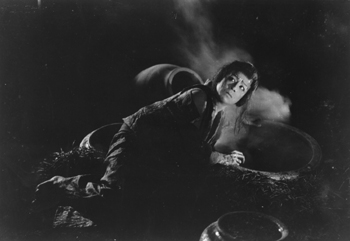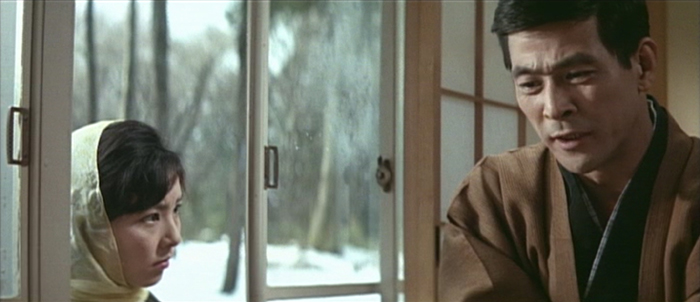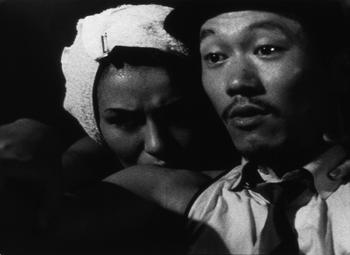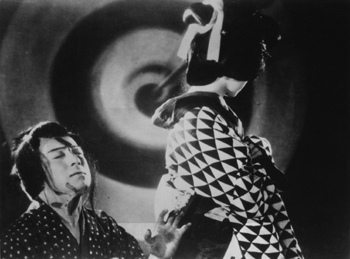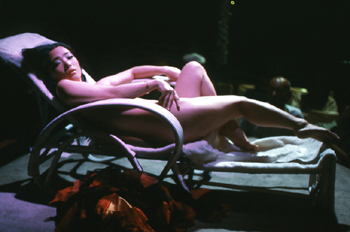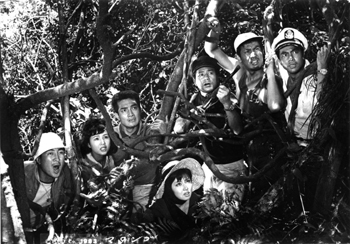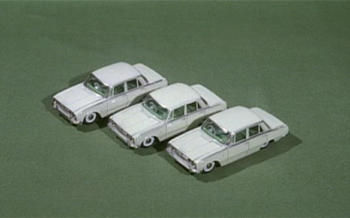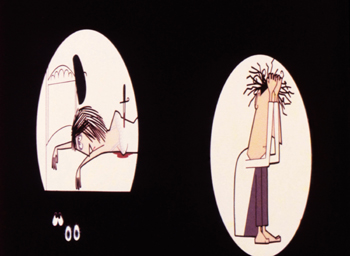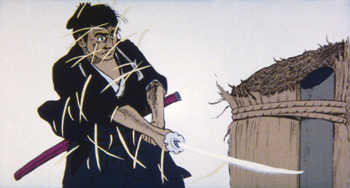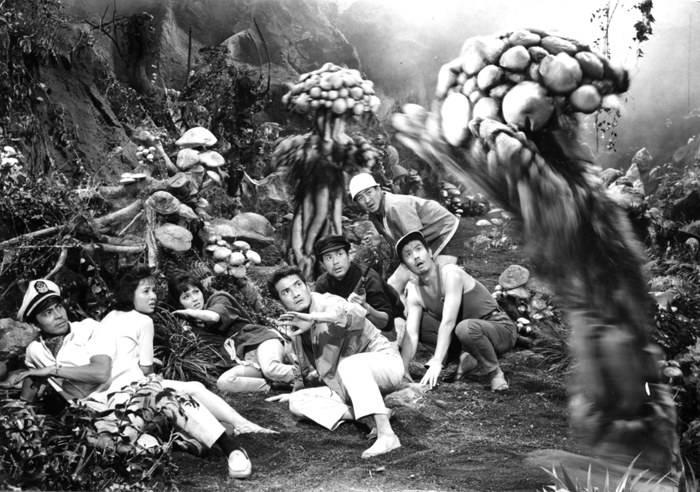 New York`s Japan Society will screen a 35mm, English subtitled print of Toho`s MATANGO as part of their `The Dark Side of the Sun: John Zorn on Japanese Cinema` film series. Photo courtesy of Japan Society. © 1963 Toho Co., Ltd.
New York`s Japan Society will screen a 35mm, English subtitled print of Toho`s MATANGO as part of their `The Dark Side of the Sun: John Zorn on Japanese Cinema` film series. Photo courtesy of Japan Society. © 1963 Toho Co., Ltd.Monthly Film Series Highlights Lesser-known and Overlooked Works from Six Japanese Directors Source: Japan Society Special Thanks to Shannon Jowett The Dark Side of the Sun: John Zorn on Japanese Cinema October 18, 2014-February 20, 2015, at Japan Society New York, NY - Japan Society`s 2014-15 Monthly Film Series invites cinephiles to discover or re-discover Japanese cinema through the eyes of one of its most ardent fans. Maverick avant-garde composer, musician and arranger John Zorn calls upon his deep love and knowledge of Japanese cinema to spotlight lesser-known or overlooked works from six Japanese directors.
The Dark Side of the Sun: John Zorn on Japanese Cinema launches with Atsushi Yamatoya`s psychedelic INFLATABLE SEX DOLL OF THE WASTELANDS (October 18), followed by Teinosuke Kinugasa`s 1928 avant-garde silent drama CROSSROADS (November 15), screened with a live improvised score by master shamisen player Yumiko Tanaka; Yoshimitsu Morita`s playful pink film TOP STRIPPER (December 11); and MATANGO (aka ATTACK OF THE MUSHROOM PEOPLE) (January 23), directed by Ishiro Honda (GODZILLA). The series concludes with the U.S. premiere of Nagisa Oshima`s whimsical made-for-television movie IT’S ME HERE, BELLETT, coupled with eight experimental shorts by the "godfather of anime" Osamu Tezuka. All films have never been shown at Japan Society before, and all but the Tezuka shorts are unavailable on DVD in the U.S. "John Zorn is one of the greatest champions of Japanese culture in our city," says Yoko Shioya, Artistic Director at Japan Society, who oversees the Film and Performing Arts programs. "In the past, the Society’s Performing Arts Program had worked with him to present several experimental music series featuring Japanese avant-garde musicians, and last year we were honored to be one of the venues included in Zorn@60, the New York City-wide festival celebrating his 60th birthday. It was during this time that I approached John, whose distinctive and uncompromising tastes run the gamut, to curate a film series that unearths `hidden gems` of Japanese cinema. His inspired selections are mostly unknown to general U.S. film-going audiences and show a side of Japanese cinema that is not represented by the major canonical auteurs that usually get repertory screenings." An enormous fan of Japanese music, art and cinema since the early 1960s, John Zorn made his first trips to Japan 30 years ago. "Late night Tokyo TV [in the 80s and 90s] provided a peek into an entirely different world outside the classic art film masterpieces of Ozu, Mizoguchi, Kurosawa and Inagaki," says Zorn in the program liner notes. "It was a revelation to discover that Oshima’s CRUEL STORY OF YOUTH and THE SUN`S BURIAL were not so much an isolated vision, but actually two examples of an entire cinematic genre, and that directors like Seijun Suzuki , Kinji Fukasaku , Toshio Masuda, Yasuzo Masumura, Teruo Ishii and others had made incredible and uncompromising films that spoke as much about the Japanese psyche as origami, noh theater or the tea ceremony ever had."
He continues, "As I got deeper into this hidden world and began exploring the small revival houses and `porno` theaters that peppered the Tokyo landscape, I learned of directors like Noboru Tanaka, Koji Wakamatsu, Tatsumi Kumashiro and Gaira, and that Roman Porno and pink films provided young directors an outlet and a creative freedom that often resulted in extremely interesting and imaginative films that revealed a side of Japan largely unknown to the rest of the world." Zorn brought back hundreds of videos from Japan and organized free underground screenings at Anthology Film Archives, Knitting Factory and various other downtown venues under the title "The Dark Side of the Sun. " He notes that the Japan Society incarnation of the series presents "a wide range of styles and formats -- jidaigeki, erotica, film noir, comedy, horror, anime -- but they all share a stunning visual sense, an imaginative playful creativity, dark sense of humor and rather bleak worldview. For me, the experimental, adventurous, and uncompromising side of any society is often the home of the deepest truths, and these films each hold their truths to an often uncomfortable extreme." The Dark Side of the Sun: John Zorn on Japanese Cinema screens monthly at Japan Society from October 2014 to February 2015. Tickets to each screening are $12/$9 Japan Society members, seniors and students, except the screening of Crossroads November 15, which are $15/$12. Tickets can be ordered online at japansociety.org or by calling the box office at 212-715-1258, Mon-Fri, 11:00 am-6:00 pm, and weekends during gallery exhibitions 11:00 am-5:00 pm. To purchase group tickets of 10 or more, please contact This email address is being protected from spambots. You need JavaScript enabled to view it..
SCREENING SCHEDULE & FILM DESCRIPTIONS INFLATABLE SEX DOLL OF THE WASTELANDS (?????????, Koya no Datch Waifu) Saturday, October 18 at 7:00 pm **Opening Film, Followed by a Reception
1967, 85 min., 35mm, b&w, in Japanese with English subtitles. Directed by Atsushi Yamatoya. With Yuichi Minato, Shohei Yamamoto, Noriko Tatsumi, Akaji Maro, Miki Watari, Taka Okubo, Masayoshi Nogami, Kohei Tsuzaki, Minoru Sawada. Taking hints from Ambrose Bierce’s celebrated short story An Occurrence at Owl Creek Bridge, Atsushi Yamatoya’s INFLATABLE SEX DOLL OF THE WASTELANDS is a deliciously delirious cult film about a hitman (Yuichi Minato) who is hired by a rich real estate agent to find an abducted woman (Noriko Tatsumi). This simple setup gives way to a hip and chaotic worldview full of hard-boiled characters, sexy action, and hallucinatory imagery. A close collaborator with the likes of Koji Wakamatsu, Yamatoya was part of the group of anonymous writers who worked on Wakamatsu Productions and was also one of the anonymous writers on the script of Seijun Suzuki’s BRANDED TO KILL. Though considered a “pink film,” INFLATABLE SEX DOLL OF THE WASTELANDS has surprisingly few sex scenes. Nevertheless, the film remains incredibly sexy through creative montage and innuendo. In his book Behind the Pink Curtain, Jasper Sharp calls the film “probably the most idiosyncratic work the genre has ever produced.” A feast for the eyes as well as the ears, the sparse and cool music was provided by jazz pianist and composer Yosuke Yamashita. INFLATABLE SEX DOLL OF THE WASTELANDS was produced by Wakamatsu Productions; this screening commemorates the life of the life of Koji Wakamatsu, who passed away on October 17, 2012. CROSSROADS (???, Jujiro) Saturday, November 15, 7:30 pm **Followed by a reception with Yumiko Tanaka, who performs the live shamisen score **Part of Japan Society’s Performing Arts Program`s Shamisen Sessions concert series
1928, 87 min., 35mm, b&w, silent, with English and German intertitles. Directed by Teinosuke Kinugasa. With Akiko Chihaya, Junosuke Bando, Yukiko Ogawa, Ippei Soma, Misao Seki, Yoshie Nakagawa. For this special screening of Teinosuke Kinugasa’s silent avant-garde tragedy, experimental shamisen player Yumiko Tanaka provides live accompaniment. Made two years after his well-known masterpiece A PAGE OF MADNESS, CROSSROADS was the last film to be made in Kinugasa’s independent production company. In this story about a poor brother and sister, the brother falls madly in love with cold-hearted Oume from Yoshiwara, the entertainment district in Edo. Literally blinded as a result of his love, he seeks help from his ever-loving older sister who is moved to sacrifice herself to protect her younger brother. The film is famously a period piece (jidaigeki) with no sword fights, an attempt that was unheard of at the time. CROSSROADS is also distinguished as the first Japanese film to have a theatrical run in Europe. With emphasis on psychology and heavy influences by German Expressionism, the film bursts with unbridled imaginative visual exploration. TOP STRIPPER (???????????, Maruhon Uwasa no Sutorippa-) Thursday, December 11, 7:00 pm
1982, 67 min., 35mm, color, in Japanese with English subtitles. Directed by Yoshimitsu Morita. With Kensuke Miyawaki, Ayako Ota, Yuji Yoshikawa, Kaori Okamoto, Nami Misaki, Jun Ueno. In this irreverent coming-of-age story, young man Yoichi (Kensuke Miyawaki) falls head-over-heels in love with Gloria (Kaori Okamoto), who works at the local strip joint. Innocent Yoichi attends Gloria’s shows every day as his mind is filled with images of her. Unlike many hot and heavy pink films of the time, there is a lot of levity to TOP STRIPPER, along with profound moments of bittersweet disappointment familiar to the young love genre. Still early in his career, Morita was one of the handful of young, radical directors who were given the opportunity to explore the visual medium via the constraints of the pink genre. The creative shots and framing and the overall playfulness is a must-see. This film was the first of the pink films that Morita directed and was made one year before he directed his iconic THE FAMILY GAME. 18+ This film is unrated, but may only be viewed by persons 18 years of age and older. MATANGO (aka ATTACK OF THE MUSHROOM PEOPLE) (????, Matango) Friday, January 23, 7:00 pm
1963, 89 min., 35mm, color, in Japanese with English subtitles. Directed by Ishiro Honda. With Akira Kobai, Hiroshi Koizumi, Hiroshi Tachikawa, Kenji Sahara, Kumi Mizuno, Miki Yashiro, Yoshio Tsuchiya. Prolific director Ishiro Honda made MATANGO nine years after his iconic GODZILLA. Like that famous kaiju film, MATANGO manages to be a highly entertaining genre film utilizing imaginative monster costumes while also engaging with social and moral commentary about contemporary Japan. A group of rich Tokyo elites -- the benefactors of the economic recovery of the 1960s -- find themselves on a deserted island after their yacht is shipwrecked. As circumstances become increasingly difficult, the moralities of the characters are tested as they struggle to survive against the monstrous and radioactive mushroom species called “Matango” that infest the island. Hallucinatory sequences, sexual tension and gripping suspense charge this colorful B-movie based on William Hope Hodgson’s 1907 short story The Voice in the Night (one of the stories printed in the anthology Alfred Hitchcock Presents: 12 Stories They Wouldn’t Let Me Do on TV). IT’S ME HERE, BELLETT; Preceded by 8 Experimental Shorts by Osamu Tezuka Friday, February 20, 7:00 pm IT’S ME HERE, BELLETT (??????, Watashi no Beretto) **U.S. Premiere
1964, 27 min., HDCAM, color, in Japanese with English subtitles. Directed by Nagisa Oshima. With Aso Sato, Sumie Kato, Saburo Houya, Akiko Koyama, Hiroshi Yagyu, Kenji Sugawara, Yoshiko Ieda, Yoriko Saito. One of the few films produced by the Directors Guild of Japan was a promotional film for the Isuzu Bellett -- a sedan car that began manufacture in Japan in 1963. Starting with Yasujiro Ozu as advisor to the script, the credits include a slew of A-list film directors such as Heinosuke Gosho and Yoshitaro Nomura. The hip jazz soundtrack was by jazz pianist and composer Hachidai Nakamura (also famous for being the composer of the hit song “Sukiyaki”). This mid-length movie is composed of 3 parts, each featuring the Bellett prominently. Each part has a different mood and different colors with part 2 starring Akiko Koyama, Oshima’s wife. Originally made for television, this must-watch for Oshima fans is the first-ever official screening in the U.S. 8 Experimental Shorts by Osamu Tezuka The grandfather of anime, Osamu Tezuka, creator of legendary works such as Astro Boy and Buddha also made experimental shorts to explore the possibilities of animation. For this screening, Zorn selects 8 of his favorites:
MALE (??, Osu), 1962, 3 min., DVD, color, in Japanese with English subtitles. Directed by Osamu Tezuka. A man in a dark room is tormented by a cool cat who wants to make love to his girlfriend cat in peace. MEMORY (????, Memorii), 1964, 5 min., DVD, color, in Japanese with English subtitles. Directed by Osamu Tezuka. In what seems at first to be a light-hearted contemplation on memory, this creative multi-media animation takes a more ironic and cautionary tone. MERMAID (??, Ningyo), 1964, 8 min., DVD, color, no dialogue. Directed by Osamu Tezuka. Set to Claude Debussy’s "Prelude to the Afternoon of a Faun" and set in a society where no daydreaming and imagination is allowed, a boy is imprisoned for claiming that a fish he rescued had turned into a mermaid. THE DROP (???, Shizuku), 1965, 4 min., DVD, color, no dialogue. Directed by Osamu Tezuka. A gag-ridden comedy about a man lost on a raft and his struggle to get the last drop of water fall into his thirsty mouth. The task proves to not be so easy. THE GENESIS (???, Souseiki), 1968, 3 min., DVD, color, in Japanese with English subtitles. Directed by Osamu Tezuka. A parody of John Huston’s 1966 religious epic, THE BIBLE: IN THE BEGINNING… The intention was to make fun of this high-budget production using basically no budget at all.
PUSH (????, Pusshu), 1987, 4 min., DVD, color, in Japanese with English subtitles. Directed by Osamu Tezuka. In this simple and sharp satire, a man buys everything brand new from vending machines. He eventually goes to God and asks for a brand new Earth. MURAMASA (??, Muramasa), 1987, 8 min., DVD, color, no dialogue. Directed by Osamu Tezuka. A warrior finds a cursed sword stuck in a straw figure and begins cutting more straw figures, only to find them turn into humans once cut. A dark cautionary tale for a world dependent on nuclear weapons. Characters were designed by master kirie (paper cutting) artist Hyakkimaru. SELF-PORTRAIT (???, Jigazou), 1988, 13 sec., DVD, color, no dialogue. Directed by Osamu Tezuka. The last of Tezuka’s experimental animation, his own face becomes a slot machine of various characters. CURATOR John Zorn has created an influential body of work that defies academic categories, drawing on a variety of genres including jazz, rock, hardcore punk, classical, klezmer, film, cartoon, popular and improvised music. He claims a wide range of influences: American musical innovators such as Ives, Varese, Cage, Carter and Partch; the European traditionalists, including Berg, Stravinsky, Ligeti and Kagel; soundtrack composers Herrmann, Morricone and Stalling; and avant-garde theater, film and art. A native New Yorker, he has been a central figure in the city’s music scene since the 1970s. Zorn maintained an apartment in Tokyo from 1986 to 1996 and spent many months observing, influencing and being influenced by Japanese culture.
About Japan Society
The Japan Society Film Program offers a diverse selection of Japanese films, from classics to contemporary independent productions. Its aim is to entertain, educate and support activities in the Society`s arts & culture programs. The Film Program has included retrospectives of great directors, thematic series and many U.S. premieres. Some original film series curated by Japan Society have traveled to other U.S. venues in tours organized by the Film Program. Founded in 1907, Japan Society is a multidisciplinary hub for global leaders, artists, scholars, educators, and English and Japanese-speaking audiences. At the Society, more than 100 events each year feature sophisticated, topically relevant presentations of Japanese art and culture and open, critical dialogue on issues of vital importance to the U.S., Japan and East Asia. An American nonprofit, nonpolitical organization, the Society cultivates a constructive, resonant and dynamic relationship between the people of the U.S. and Japan. Japan Society is located at 333 East 47th Street between First and Second avenues (accessible by the 4/5/6 and 7 subway at Grand Central or the E and M subway at Lexington Avenue). For more information, call 212-832-1155 or visit japansociety.org/film.



